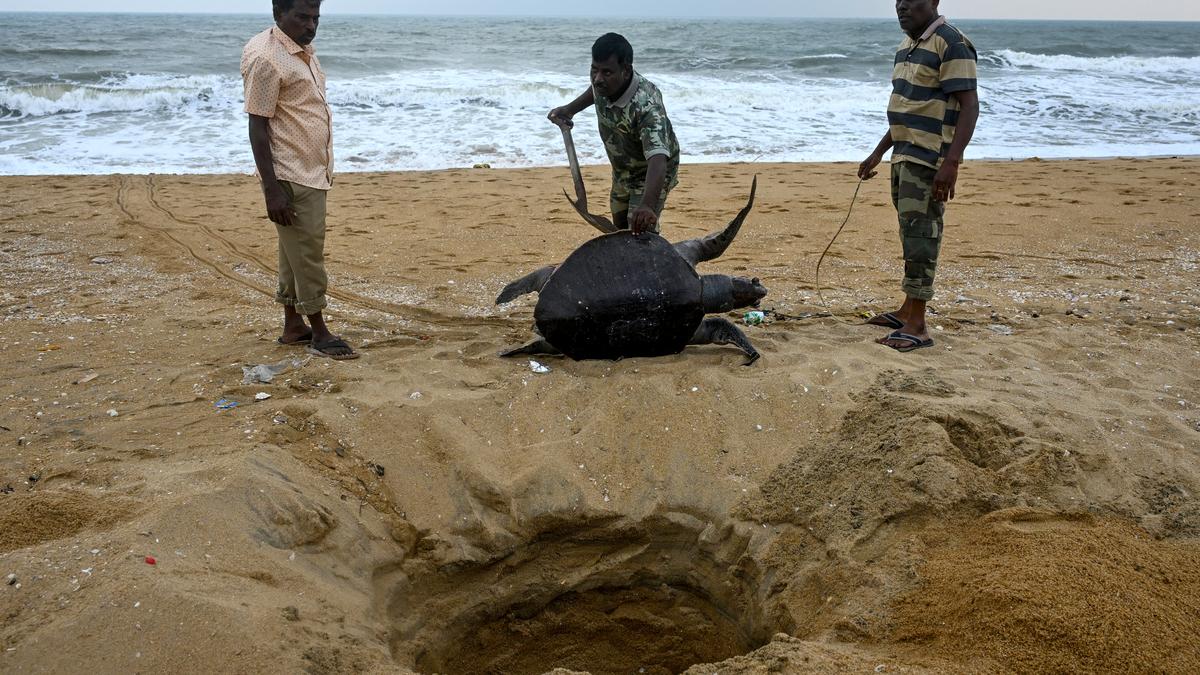
A surge of dead sea turtles in the sand Premium
The Hindu
Hundreds of Olive Ridley turtle carcasses have been found since January 2025 in Tamil Nadu’s Chennai and Chengalpattu districts; conservationists say number of deaths three times than usual during mating season and sound alarm bells about bottom trawling, widespread use of fishing gear, and plastic pollution
On a sunny day in January, A. Prakash, 40, sits on a boat in Kovalam, off the East Coast Road (ECR) in Chengalpattu district of Tamil Nadu. He has just returned from a fishing trip where he saw 10 Olive Ridley sea turtle carcasses floating in the sea. “We (fisherfolk) have been seeing many such carcasses every day since the beginning of the year,” he says, perturbed.
Prakash points to an elderly woman nearby, who comes to pick up a basket of tiger prawns from the boat, and says her son helps the Forest Department bury the carcasses. Placing the basket deftly on her head, Rani, 65, says, “My son just buried six and came home tired and hungry.”
In the Chennai and Chengalpattu districts, located along the 1,076 kilometre-long coastline of Tamil Nadu, many people recall seeing dead Olive Ridley sea turtles washed ashore this year. C. Gnanasekar, 44, a fisherman from Uthandi, off ECR, spotted four of them in the first week of January. Rajiv Rai, 69, from Injambakkam in Chennai, says he has seen about 80 since the first week of the year. Maria, a nature enthusiast, says she saw 24 at Nemmeli Kuppam in Chengalpattu.
Olive Ridley turtles, which are found in warmer waters, such as the southern Atlantic, Pacific, and Indian Oceans, haul themselves up on to India’s eastern shore every year by the tens of thousands and lay eggs in an event known as arribada (arrival by sea in Spanish). While Odisha is a mass nesting site for Olive Ridley turtles in India, thousands of these small wild animals also come sporadically to nest between December and April along the Tamil Nadu coastline, a lifeline for millions who depend on fishing for their livelihood. The biodiverse and eco-sensitive Gulf of Mannar, located off the districts of Thoothukudi and Ramanathapuram in the south, is an essential feeding site for these turtles. The creatures then migrate to Odisha, West Bengal, and beyond.
Along the 34-km coast from the Marina Beach in Chennai to Kovalam in Chengalpattu, seeing dead sea turtles on the shore during mating season is not unusual — every year, an average of 350 dead turtles can be found, says Shravan Krishnan, a volunteer with the Students Sea Turtle Conservation Network (SSTCN). However, this year, until January 31, conservationists had counted 1,200 dead sea turtles, more than three times the normal figure. The Tamil Nadu Forest Department provided a more conservative estimate (706 turtles until January 23). The Department has refused to provide numbers since then.
To make matters worse, the number of sea turtle nests along the shores has been unusually low. “Most turtles that were to nest have died. All the dead female turtles we bury have eggs in their bodies,” says Gnanasekar, who has been working with the TREE Foundation, a marine conservation organisation, for two decades.
Olive Ridleys are the smallest of the seven sea turtle species. They weigh up to 45 kilogrammes and reach only about 2 feet in shell length. Their name comes from their olive-coloured carapaces (hard upper shells). Though their numbers have remained stable in recent years, Olive Ridleys remain a key species in global conservation efforts and are classified ‘vulnerable’ by the International Union for Conservation of Nature Red List.













